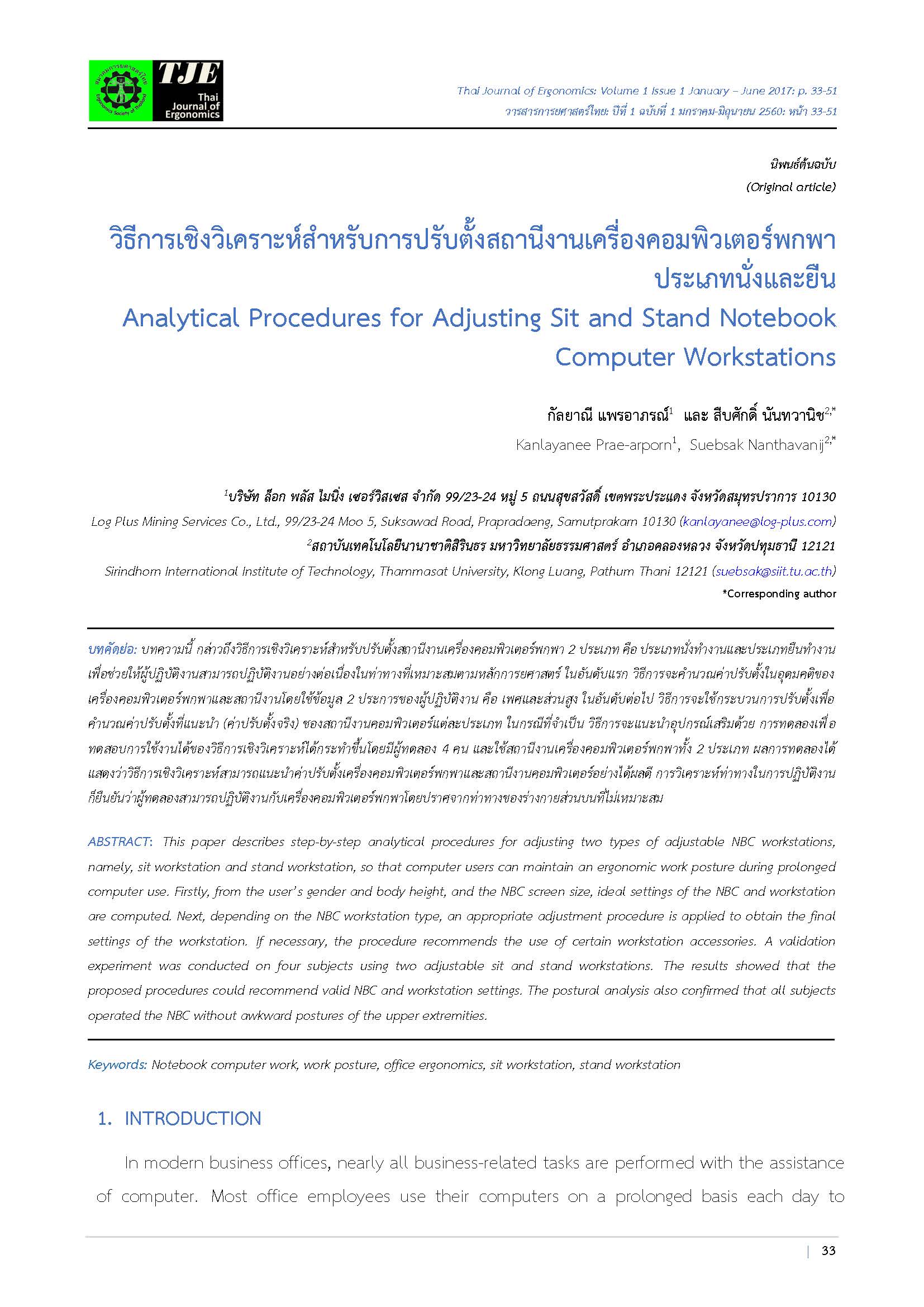Analytical Procedures for Adjusting Sit and Stand Notebook Computer Workstations
Main Article Content
Abstract
This paper describes step by step analytical procedures for adjusting two types of adjustable NBC workstations, namely, sit workstation and stand workstation, so that computer users can maintain an ergonomic work posture during prolonged computer use. Firstly, from the user’s gender and body height, and the NBC screen size, ideal settings of the NBC and workstation are computed. Next, depending on the NBC workstation type, an appropriate adjustment procedure is applied to obtain the final settings of the workstation. If necessary, the procedure recommends the use of certain workstation accessories. A validation experiment was conducted on four subjects using two adjustable sit and stand workstations. The results showed that the proposed procedures could recommend valid NBC and workstation settings. The postural analysis also confirmed that all subjects operated the NBC without awkward postures of the upper extremities.
Article Details

This work is licensed under a Creative Commons Attribution-NonCommercial-NoDerivatives 4.0 International License.
References
Brand JL. Office ergonomics: A review of pertinent research and recent developments. Reviews of human factors and ergonomics. 2008 Oct 1;4(1):245 82.
Shikdar AA, Al Kindi MA. Office ergonomics: deficiencies in computer workstation design. International Journal of Occupational Safety and Ergonomics. 2007 Jan 1;13(2):215 23.
Mueller GF, Hassenzahl M. Sitting comfort of ergonomic office chairs developed versus intuitive evaluation. International Journal of Occupational Safety and Ergonomics. 2010 Jan 1;16(3):369 74.
Amick BC, Menéndez CC, Bazzani L, Robertson M, DeRango K, Rooney T, Moore A. A field intervention examining the impact of an office ergonomics training and a highly adjustable chair on visual symptoms in a public sector organization. Applied ergonomics. 2012 May 31;43(3):625 31.
Asundi K, Odell D, Luce A, Dennerlein JT. Changes in posture through the use of simple inclines with notebook computers placed on a standard desk. Applied ergonomics. 2012 Mar 31;43(2):400 7.
Jonai H, Villanueva MB, Takata A, Sotoyama M, Saito S. Effects of the liquid crystal display tilt angle of a notebook computer on posture, muscle activities and somatic complaints. International Journal of Industrial Ergonomics. 2002 Apr 30;29(4):219 29.
Standards Australia. Screen based Workstations. Part 2: Workstation Furniture (AS3590.2 1990). Standards Association of Australia, Homebush (NSW). 1990.
American National Standards Institute. ANSI/HFES 100 2007 Human Factors Engineering of Computer Workstations. Human Factors and Ergonomics Society, Santa Monica, CA. 2007.
Woo EH, White P, Lai CW. Ergonomics standards and guidelines for computer workstation design and the impact on users’ health–a review. Ergonomics. 2015 Sep 24:1 2.
Jalil S, Nanthavanij S. Analytical algorithms for ergonomic seated posture when working with notebook computers. Industrial Engineering and Management Systems. 2007 Dec;6(2):146 57.
Nanthavanij S, Prae Arporn K, Chanjirawittaya S, Paripoonyo S, Rodloy S. Novel method of computing recommended settings of notebook computer and office workstation for ergonomic work posture. Maejo International Journal of Science and Technology. 2016 Jan 1;10(1):13.
Karakolis T, Callaghan JP. The impact of sit–stand office workstations on worker discomfort and productivity: a review. Applied ergonomics. 2014 May 31;45(3):799 806.
Karakolis T, Barrett J, Callaghan JP. A comparison of trunk biomechanics, musculoskeletal discomfort and productivity during simulated sit stand office work. Ergonomics. 2016 Mar 17:1 3.
Babski Reeves K, Calhoun A. Muscle Activity and Posture Differences in the Sit and Stand Phases of Sit to Stand Workstation Use: A Comparison of Computer Configurations. IIE Transactions on Occupational Ergonomics and Human Factors. 2016 Aug 20:236 46.
Russell BA, Summers MJ, Tranent PJ, Palmer MA, Cooley PD, Pedersen SJ. A randomised control trial of the cognitive effects of working in a seated as opposed to a standing position in office workers. Ergonomics. 2015 Oct 21:1 8.
Gao Y, Cronin NJ, Pesola AJ, Finni T. Muscle activity patterns and spinal shrinkage in office workers using a sit–stand workstation versus a sit workstation. Ergonomics. 2016 Feb 5:1 8.
Garrett G, Benden M, Mehta R, Pickens A, Peres C, Zhao H. Call Center Productivity Over 6 Months Following a Standing Desk Intervention. IIE Transactions on Occupational Ergonomics and Human Factors. 2016 Apr 29(just accepted):188 95.
Klangsin P, Mekhora K, Nanthavanij S, Jalayondeja W. Effects of notebook computer workstation settings on muscle activities and postural risks. ICIC Express Lett. 2012;6:2989 94.
Thai Industrial Standards Institute. Report of the Survey and Research on the Anthropometric Data of the Thai Population. Ministry of Industry, Bangkok. 2001
McAtamney L, Corlett EN. RULA: a survey method for the investigation of work related upper limb disorders. Applied ergonomics. 1993 Apr 1;24(2):91 9.
Lueder R, Corlett N. A proposed RULA for computer users. In Proceedings of the ergonomics summer workshop 1996 Aug 8 (pp. 8 9). UC Berkley Center for Occupational and Environmental Health Continuing Education Program San Francisco.


